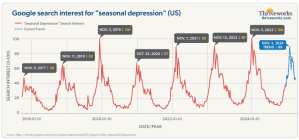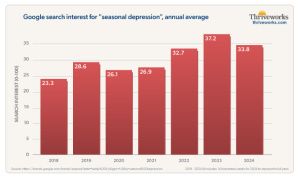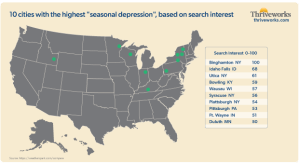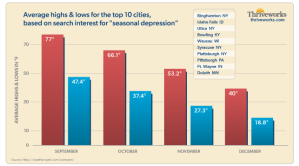
- For the third year running, Thriveworks has analyzed Google Trends data and weather patterns from the last several years to predict the peak and severity of seasonal depression in 2024 – a form of depression that occurs during seasonal changes (most often, in the fall and winter).
- According to our latest analysis, this year we can expect seasonal depression to reach its peak the first full week of November, which is when people historically start searching for more information regarding the topic — 2024’s search trends are tracking to hit 32.06% higher than in the last five years
- Overall, for the past 6 years, searches for “seasonal depression” have peaked between the months of October and December and the term has had an average growth rate in search interest of about 7 percent per year
- This data is important because knowing when to expect the onset of seasonal depression can help those who suffer from it create a treatment plan or begin preventative measures.
- If you suffer from seasonal depression, it’s important to get professional help from a mental health provider; it can also be helpful to stabilize your sleep schedule, utilize a light box, and engage in physical activity amongst other practices
The health and wellness community has long used data trends to accurately predict spikes in colds, flu, and other ailments. Similarly, for the third year running, Thriveworks has analyzed Google data and weather patterns from the past several years to predict the peak and severity of this year’s seasonal depression. The results provide at risk individuals an idea of when they should consider implementing preventative measures or beginning a treatment plan.
According to our analysis, this year in 2024, we can expect seasonal depression to reach its peak in the first full week of November. This is the time of year that, historically, people start searching for more information regarding the topic. This year’s study found that over the past three years, search interest in seasonal depression has risen 32%.
Seasonal Depression Overview: What Is Seasonal Depression?
Before we dive into our research, let’s discuss what seasonal depression — officially recognized as seasonal affective disorder (SAD) —is. “Seasonal depression is a term used to describe episodes of major depressive disorder with a seasonal pattern specifier. This specifier takes into account the onset of a depressive episode at a specific time of the year (fall and winter being most common) as well as the absence of said symptoms from the disorder at other times of the year — essentially a seasonal relationship,” explains Laura Harris, Licensed Clinical Mental Health Counselor at Thriveworks Durham.
Symptoms of seasonal depression match those of other types. These include:
- Reduced interest in day-to-day life
- General discontent
- Being withdrawn
- Feeling hopeless
- Difficulty concentrating
- Loneliness and isolation
- Difficulty sleeping
- Fatigue
- Changes in appetite
To meet the diagnostic criteria for seasonal depression, symptoms must resolve at the end of the seasonal period. For example, an individual might develop symptoms at the beginning of fall and then conclude at the start of spring. They must also experience this seasonal depressive pattern for at least two years.
Predicting Seasonal Depression
Now, we wanted to understand again exactly when seasonal depression might reach its peak this year, to better help those who suffer from it.
“By knowing how seasonal triggers affect an individual, and when they are most likely to strike, we have an opportunity to develop plans to redirect seasonal depressive phases to non-seasonal depressive phases” says Heidi Faust, LCSW, Chief Clinical Officer of Thriveworks.
“This can include accomplishing disproportionately more tasks during non-seasonal depressive phases and proactively scheduling time-specific appointments with notifications/reminders for the seasonal depressive phase. These appointments can prioritize medical and overall health-related issues and also include activities that counter the negative effects of seasonal depression.”
Such activities include socializing with others, spending time outdoors, exercising, and engaging in activities that bring you purpose. In order to estimate the peak of seasonal depression in 2024, we followed last year’s analysis – first evaluating Google data for the search term “seasonal depression” from the last 5 years (US searches only). This confirmed once again that “seasonal depression” searches regularly spike at the beginning of November.

How “Bad” Will 2024’s Seasonal Depression Peak Be?
We conducted a comparison of the 8-week time period August 6 – September 28 for “seasonal depression” search data for the last 5 years to gain insights into this year’s peak.
Over the past five years, we’ve seen a growth in search interest for the term “seasonal depression”, indicative of expanded awareness of the affliction. Between the years of 2018 through 2024, search interest for this topic has grown at an avg. annual rate of 7%, with a total increase of 32.06% in search interest for “seasonal depression” over the last three years.

Weather and Seasonal Depression
This year’s Google Trends analysis also showed where search interest for “seasonal depression” was the highest over the last five years. We found that 50% of those cities are located in the Midwest, and the other 50% are in the Northeast, meaning people in these regions are searching for “seasonal depression” more than in the rest of the country.

We then looked at weather data, including average monthly temperatures, for these 10 cities. We discovered that throughout the months of September, October, November, and December, which is when seasonal depression tends to peak, these top 10 cities experience an average temperature drop of 26.35 degrees.

This is in line with our Google Trends research, showing that search interest peaks between October and November with consistently high search volume through mid-December. This can help us conclude that the drastic change in temperature, rather than the cold temperatures alone, is a major contributor to the peak in search interest.
How to Cope with Seasonal Depression Symptoms at Home
Kate Hanselman, Board-Certified Psychiatric Mental Health Nurse Practitioner (PMHNP-BC) and Lead Nurse Practitioner at Thriveworks West Hartford recommends a few actions that can help you manage symptoms of depression during seasonal changes:
- Stabilize your sleep schedule. Sleep has a huge impact on mood that is often less than obvious! Rising at the same time every day can naturally stabilize a variable bedtime.
- Limit your use of alcohol and other substances. While it can be tempting to think that a drink or two will ease your distress, substance use is essentially guaranteed to worsen existing symptoms. If you use substances regularly, check with a professional before stopping on your own to make sure you have the support you need.
- Use a lightbox (also known as a SAD Lamp).
- Get outside at least once a day – even if it’s just a walk to the mailbox or around the block.
- Move every day, whether it’s a YouTube yoga class, a walk with the dogs, joining a fitness class, or taking the stairs, it counts!
- Engage in daily social contact, whether it’s dinner with family, helping a neighbor, or simply a text to friends.
- Building and using a coping tools box. Fill it with photos of happy times, a favorite playlist, a list of grounding or coping tools, a plan for gentle movement, a coloring book, etc.)
- Getting it down on paper. Journaling is a great tool to reflect and understand what’s happening inside. Planning out your week on a calendar and writing in time for at least one enjoyable activity daily can also help reduce overwhelm and increase joy. And if you’re overwhelmed by tasks, try writing a to-do list and crossing off one to two things daily.
Getting Professional Seasonal Depression Help
In addition to practicing the above, it’s important to seek professional depression help. “Come see us,” says Hanselman. “Meet with a mental health provider to discuss what options are available to make your symptoms more manageable, whether that’s medication, therapy, or a combination of both.”
There is much variance in providers of mental health and even more mental health approaches to assist with techniques to cope with seasonal depression. Cognitive behavioral therapy is an evidence-based approach to treating depression. Within this modality, clients are taught to identify and change unhelpful thoughts and behaviors. The role of the therapist is to teach skills that help positively align the relationship between thoughts, feelings, and behaviors.
If you’re experiencing symptoms of seasonal depression, please reach out for help. The providers at Thriveworks would be more than happy to help.













